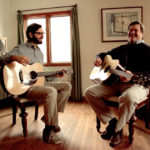
Fretting Hand Technique Exercises
In this article, I’m going to present a number of technique exercises that will help you to play single note melodies, as well as chords with your fretting hand. The exercises will all be single note picking, but the principles of stretching and strengthening your fingers will apply to all aspects of your playing. It’s advised that you read my article on fretting hand technique to supplement these exercises. The principles in these exercises are borrowed from a great book called Guitar Technic by Roger Filiberto. You should pick it up if you have the chance!
Basic Principles to Remember
- Always press down right behind the fret to get the cleanest sound, not too far behind the fret and not directly on it.
- Press down behind the fret with the very tip of your finger.
- Keep your fingers curved.
- Fingers that are not playing should remain curved and ready to play at any time.
- Economy of motion: move your fingers as little as possible to get the job done. This will pay off huge dividends later when increasing the speed of these exercises.
- Keep the pad of your thumb in the middle of the back of the neck, always facing away from you.
- Curve your wrist as little as possible.
- Palm of your hand facing up, perpendicular to the neck.
- Keep your knuckles apart from each other. This stretch is important when playing chords.
Practicing alternate picking with your right hand for all of these exercises (down-up-down-up). The x followed by dashes means to hold down that finger throughout or until the dashes end. Continue all the exercises to the low E string to make sure you cover each string.
Also, if any of these exercises are too hard to do in the first position, you can move them up the neck to any position that’s doable for you. The frets get smaller as you get higher on the neck, so it requires less finger stretch to do the exercise as you get to higher positions.
Ex. 1.1
(hold down first finger down)
x – – – – – – – – – – – – – x – – – – – – – – – – – – – x – – – – – – – – – – – – –
E|–1–2–1–2–1–2–1–2—————————————————————
B|———————————1–2–1–2–1–2–1–2——————————–
G|—————————————————————1–2–1–2–1–2–1–2–
D|———————————————————————————————
A|———————————————————————————————
E|——————————————————————————————— (continue to the low E string)
Ex. 1.2
x – – – – – – – – – – – – – x – – – – – – – – – – – – – x – – – – – – – – – – – – –
E|–1–3–1–3–1–3–1–3————————————————————
B|——————————–1–3–1–3–1–3–1–3——————————
G|————————————————————-1–3–1–3–1–3–1–3–
D|——————————————————————————————-
A|——————————————————————————————-
E|——————————————————————————————-
Ex. 1.3
x – – – – – – – – – – – – – x – – – – – – – – – – – – – x – – – – – – – – – – – – – –
E|–1–4–1–4–1–4–1–4————————————————————–
B|——————————–1–4–1–4–1–4–1–4——————————–
G|————————————————————–1–4–1–4–1–4–1–4–
D|——————————————————————————————–
A|——————————————————————————————–
E|——————————————————————————————–
Bending the Wrist and Straightening the Fingers
You may notice that these exercises are harder as you get closer to the low E string. That’s because your fingers have to reach further. The natural tendency is to bend your wrist to compensate for the added difficulty. A small amount of bend is natural as you get towards the lower strings, however, make sure to not over bend which can lead to unnecessary tension and injury.
In order to keep your wrist as straight as possible, you can gradually straighten out your fingers as you approach the low E string. This technique can also help to mute unnecessary strings.
Here are couple more exercises that use the basic principles from above to utilize all the fingers.
Ex. 2.1
x – – – – – x – – – – – – x – – – – – – x – – – – – – x – – – – – – x – – – – – –
E|——————————————————————————–1–2–3–4—
B|—————————————————————–1–2–3–4——————
G|————————————————-1–2–3–4———————————-
D|———————————-1–2–3–4————————————————-
A|——————1–2–3–4—————————————————————–
E|–1–2–3–4———————————————————————————
And then come back down…
Ex. 2.2
E|–4–3–2–1———————————————————————————–
B|——————4–3–2–1——————————————————————-
G|———————————-4–3–2–1—————————————————
D|————————————————–4–3–2–1———————————–
A|——————————————————————4–3–2–1——————-
E|———————————————————————————-4–3–2–1—
There is a pretty big leap in difficulty from the first series of exercises to the second. I’m presenting these as examples in order to apply the principles of correct fretting hand technique. For a more graduated course I highly advise purchasing Mel Bay’s Guitar Technic by Roger Filiberto. This book presents the exercises in a graduated manner, allowing you to slowly work up to the harder ones.
Fretting hand technique can be difficult in the beginning, but practice with the fundamental techniques in this article, and you’ll begin to see results in no time! Chords, scales, melodies, and solos will all be easier to play when you practice with intention. And remember, it’s always best to practice every day than to try to squeeze in a big practice session once or twice a week. This especially applies to technique practice where muscle memory is extremely important. Spread your practice sessions out over the course of the week for the best results.

